Moving to a market economy and sharing land value uplift
Returning to Sarajevo for a research conference almost fifty years after I had worked there as a management consultant for McKinsey and Company raised some fundamental questions over how the countries of Central and Eastern Europe should use their recently won ‘freedoms’ to build a more sustainable future. I was struck by how cities that were almost destroyed by civil war could recover their identity and character, but also how difficult it would be to share the new wealth with the wider population.
A Balkan tragedy?
Sarajevo was under siege for 1425 days between 1992 and 1996. With troops firing on the city from the surrounding mountains, the people lived in a state of siege, short of food and any security, the longest siege of a capital city in modern warfare. But the experience was not new. From domination by the Turks for five hundred years, and then as part of the Austro-Hungarian empire for some fifty years, before becoming part of Yugoslavia and then the Soviet bloc, Bosnia and Herzogovinia has fought for independence. But it is hard to be independent when you are so small (3.5 million) and made up of so many different communities.
Sarajevo has a fascinating old town where East meets West (left). Located among mountains with lots of water power (top right). Muslims, Christians and Jews have co-existed for centuries (bottom right).
The country is not only split by religion but also by mountains. These make communications difficult but also foster diversity, and Sarajevo was rightly a candidate for European City of Culture. Thus there are several scripts, and in a notable square a Moslem mosque, a Christian Church and a Jewish synagogue stand next to each other. Known principally as the place where Archduke Ferdinand was assassinated, and therefore the spot that ignited the First World War, the city lies in the contested strip of the Balkans, where conflict has been part of life for centuries. Yet as the great local write Ivo Andric points out in his Nobel prize winning novel The Bridge on the Drina, people from very different background and cultures managed to coexist. The results are clearly visible in the fascinating streets and public places that have been rebuilt after the civil war, many still showing where they had been struck by shells.
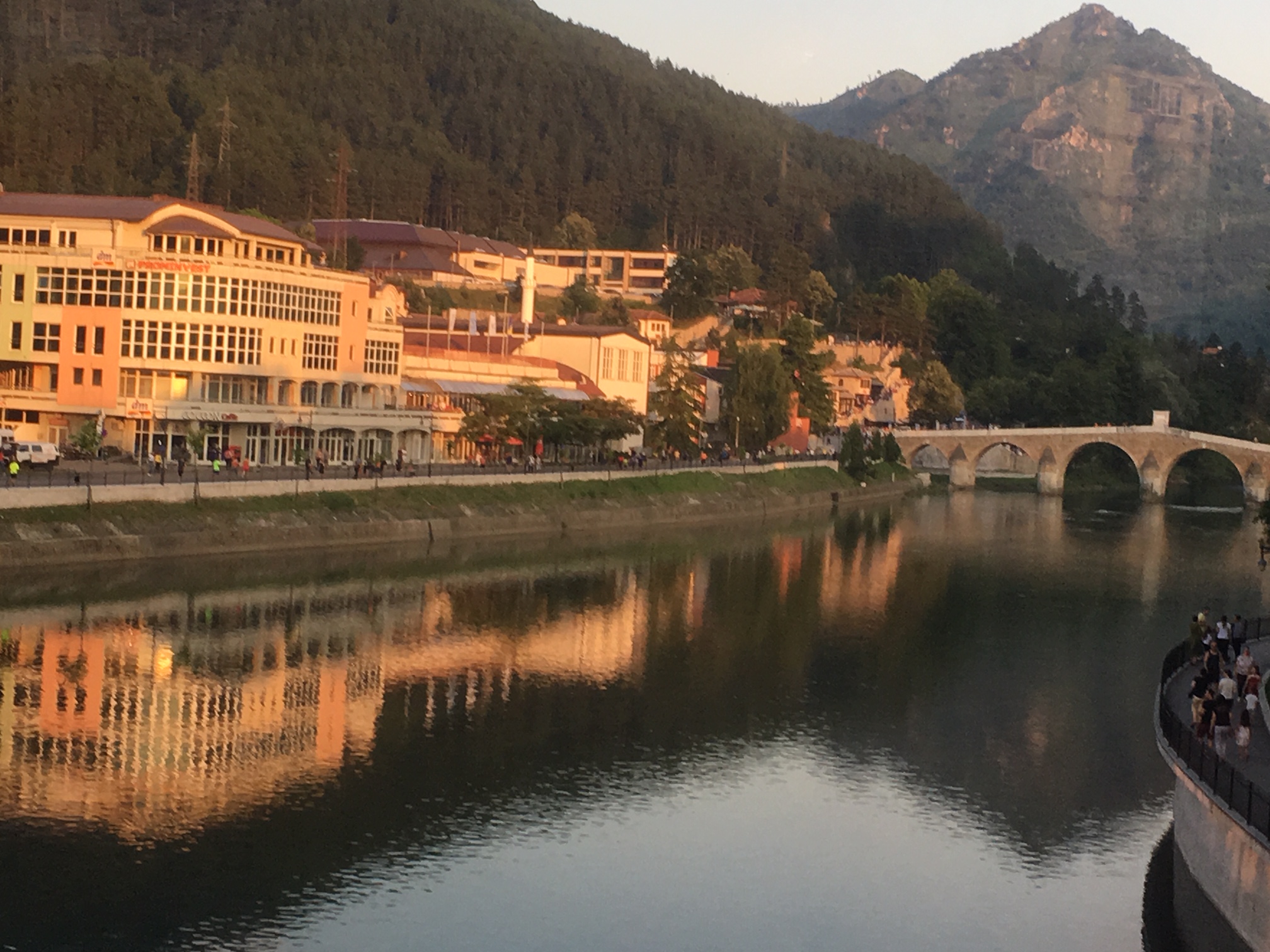
The city is split by mountains.
Today the atmosphere is very relaxed. A Western visitor is impressed by the contrasts between the young Muslim girls in their stylish outfits and their Western dressed counterparts mingling together in the lively atmosphere of the Old Town, while black garbed tourists from the Middle East look on. Cafes serving ‘Bosnian’ coffee and dishes like Burek and the local Cevapcici grilled sausages contrast with the bars on the edge of town, with their loud music and Western ways. In the town of Mostar tourists gather to walk over the ancient bridge, the first part of the old town to be rebuilt after hostilities ended. The sounds of the Christian church bells compete with the cries of the Muezzin from the many minarets. Somehow the ancient character has survived a brutal civil war.
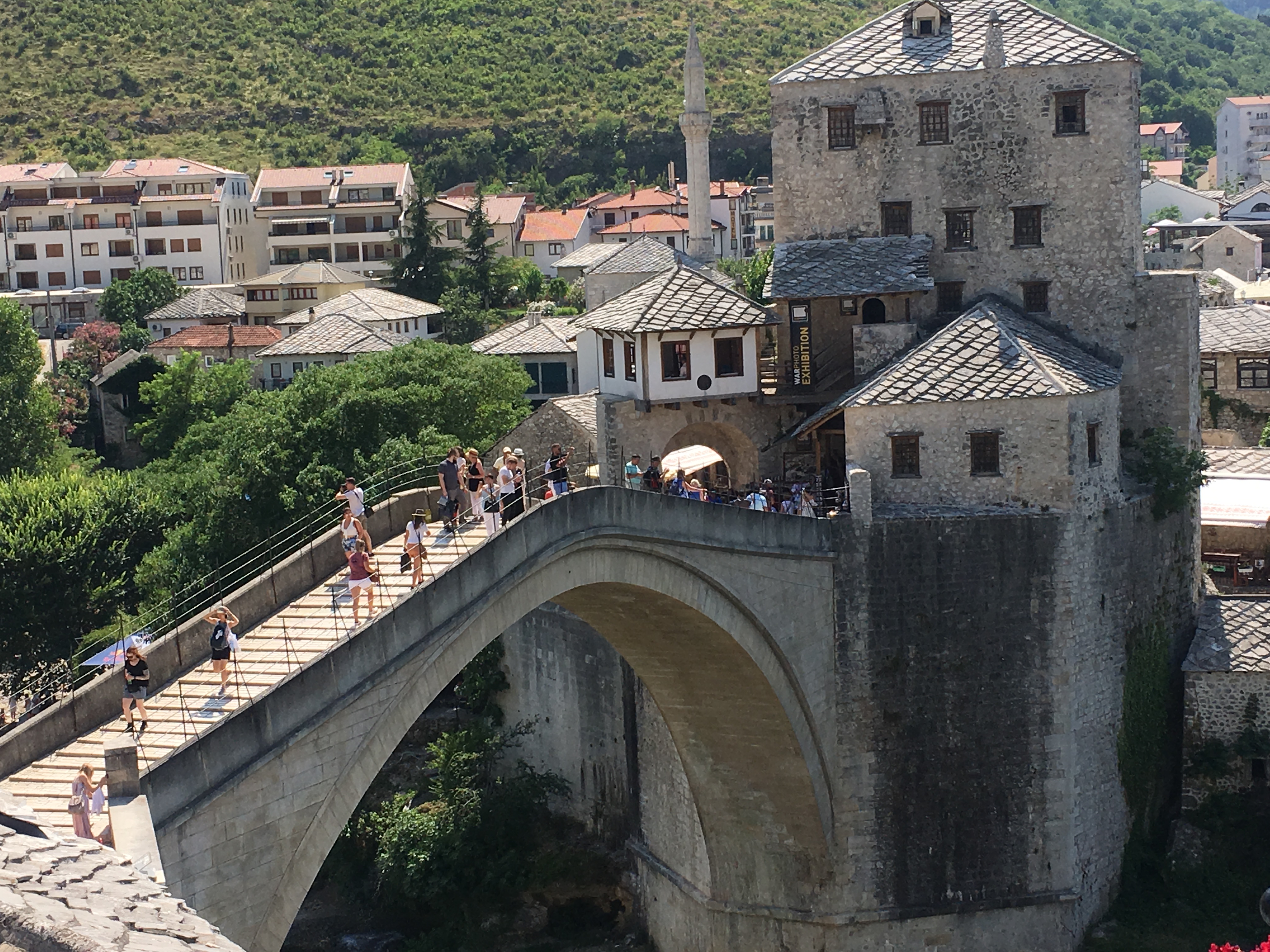
Bosnia’s heritage draws tourists, like the bridge at Mostar.
Linear city
Sarajevo’s position along a valley between mountains has produced a relatively sustainable urban form. One of the first urban tramways, built by the Austrian rulers in 1885 as a test line for Vienna, now runs for 14 miles with 28 stops, and with turning circles at each end. The old-fashioned tram fleet includes cast-offs from Washington, the Czech Republic and Amsterdam. Trams seem to run every few minutes on the main route, which can be quite bumpy in parts. A one-way tram ticket only costs £1.50, and ticket inspections are frequent. The high density and mixed nature of the urban population means that public transport is very busy. On either side of the spine line are all the main attractions, from a City Hall built in a Moorish style, classical museums to modern office blocks. At one end is the Old Town, where coffee drinking predominates, while at the other, where the conference was held, is an unplanned kind of new town just off the airport runway, with lots of noisy bars.
Buildings like City Hall have been restored after the civil war (left). The city was shelled from above and cut off from food (right). The streets are lively (below).
But travelling out to Mostar, some two and a half hours away over the mountains, it was clear that development was sprawling everywhere. So the high density blocks of flats being built in the centre are competing with new suburbs and the pleasures of living in the country. Consequently, as in most cities, congestion is increasing and air quality is suffering. When I had previously worked in Sarajevo the smog was so dense it was impossible to see anything, thanks largely to buildings being heated with low quality fuel oil called Naptha. Today the air looks cleaner but is polluted by the private cars of those living elsewhere.
The large modern bus and train stations adjoin each other, so it should have been easy to create an integrated transport service if privatisation had not got in the way. It appears that those who can, use their cars. Unfortunately the train line, which has been upgraded with Talgo trains, only runs an early morning and late evening service between the two towns, which makes it impractical for the visitor to use, and so it is a neglected asset.
An old-fashioned tram connects the city together (left). Outside the city, the suburbs sprawl along the main road (top right). Recent developments look unplanned (bottom right).
The company our team from McKinsey was advising, Energoinvest, is still building power plants, transmission systems and now ‘smart city grids’ in over a hundred countries. But the successful Yugoslav model of ‘workers self-management’ has been replaced by Western investment in foreign owned businesses, that now occupy the stylish office blocks that have been built along the line. There is no obvious division between neighbourhoods by religion, but undoubtedly there are growing differences in the kinds of housing people occupy. My fear is of a growing polarisation between city dwellers and those living in the rapidly growing suburbs. How could a city government meet growing expectations when the prevailing values are to maximise private wealth?
Capturing land values
The conference had been organised by a network of researchers supported by a grant from the EU under the COST scheme, which stands for European Cooperation in Science and Technology. University based researchers in some 27 countries are collaborating over a four year period through a network called PUVACA, which stands for Public Value Capture of Increasing Property Values www.puvaca.eu. The event was a chance to review the philosophy of land value capture as well as to draw on case studies of experience in a variety of countries. 150 papers and 17 books had been reviewed, and the OECD has started an eighty country review of land value capture, now that cities everywhere are looking for new sources of funding for infrastructure.
Discussions revealed the need to go beyond looking for funds from developers and land owners to changing the way development is planned and property is taxed so that beneficiaries of public investment contribute towards the costs. A great deal depends on the context. Capital cities like Prague or Tallinn attracting international capital, while second cities like Brno or the rest of Estonia get little investment. In successful Western cities such as Bordeaux and Munich, where land values are rising at 15% a year, there is agreement over the need to control development for the public good. By contrast in what are politely called the Inclusiveness Target Countries which have overthrown the old Communist systems, even where the constitutions allow some form of property taxation, the prevailing views of politicians is to let the market determine what happens, and very little is raised.
The conference was organised by the research network PUVACA
What we call negotiation in Northern Europe is seen as corruption in the Mediterranean countries. There are no common principles or values to help finance the infrastructure that cities need. As a consequence, development is taking place in a fragmented and uncoordinated way, with little regard to the UN’s principles of sustainable development and the New Urban Agenda. After the fall of Communism, private property rights dominated decision making. As people were able to acquire the flats they had once rented they were happy for a while. Though the UN’s Urban Agenda has highlighted the importance of capturing increasing property values, as has the World Bank in its research into how to finance transport infrastructure, politicians pay little regard to concerns such as limiting car use, and upgrading public transport or the needs of the homeless. Instead they prefer iconic modern buildings that symbolise progress and appeal to their supporters. So grand projects such as Wilanow New Town in Poland are getting no developer contributions to social infrastructure and will suffer.
The experience of Munich was particularly interesting, where the City has pioneered Socially Responsible Land Use Planning (SOBON) and is currently planning a new town to meet the demand for 5-6,000 units a year. Developers enter into contracts with the city before land is rezoned to cover both social and ecological impacts. One third of the value goes to the city to pay for infrastructure, and in all 50% of the uplift in land values can be captured. The city council employs more lawyers than planners, as negotiation is critical to success.
We also learned of the French experience, where local authorities can secure 3-4% of the value of the project in benefits such as affordable housing (14% in Bordeaux and 22% in Strasbourg. Ghent in Belgium is another good model where 12% of housing is social. Flemish cities can secure 20% social housing in new private developments and 40% on public land. Support is also provided in the form of lower transfer costs (1.5% versus 10%) and lower VAT on construction (6% vs 21%) . Intriguingly while the Flemish GNP per capita is amongst the highest in Europe, incomes in neighbouring French Wallonia are not so much lower thanks to people working in Brussels or getting social benefits. While developers have appealed against ‘disproportionate obligations’, the Courts apparently consider them acceptable where necessary to ‘guarantee sufficient housing for low income or disadvantaged sections of the population.’
Conclusion
The potential for tapping land values is therefore fundamentally different in successful Western countries and in cities where politicians have little respect for professionals who threaten their positions, and where corruption is commonplace. But as Jonathan Manns and I pointed out in our contribution, in the UK it is only in the extended travel to work area around London, that is the Greater South East, where house prices have risen most and land values are high enough to be taxed without losing investment. Consequently instead of looking for universal public policies, it is better to enable local authorities to devise systems that suit the local context. However developers everywhere will resist paying upfront when values are only achieved when property is occupied after some years of hard work. They also will prefer providing benefits in kind that enhance the overall appeal of the development.
The research is already enabling experience to be shared. My hope is that promising conversations with researchers based in Dresden and Vienna may enable comparisons to be made with English cities that are also having to rebuild their economies and institutions, and that want to put proactive planning policies into practice to build both better and fairer places.
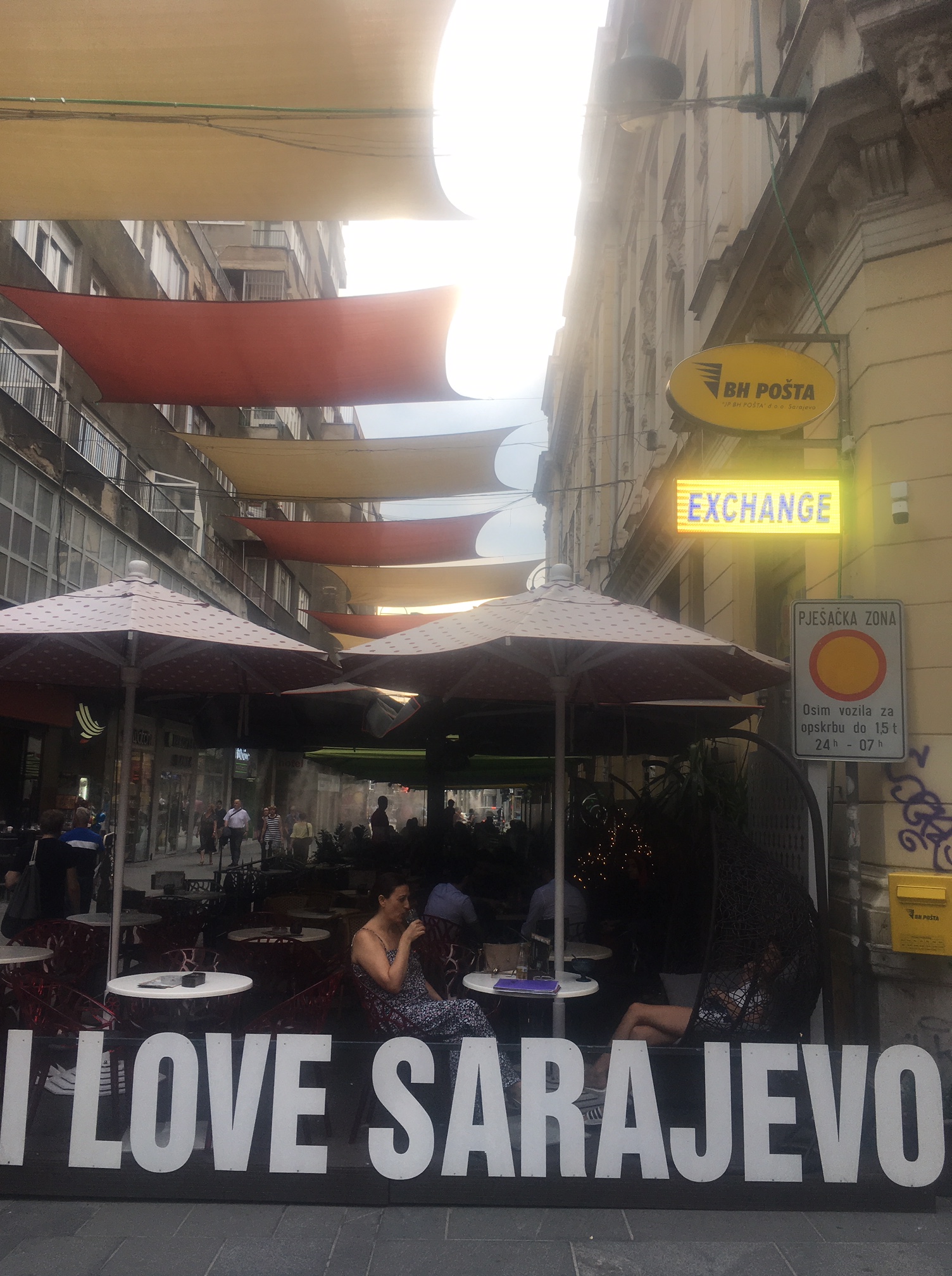


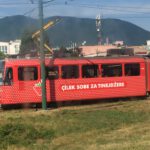
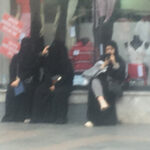
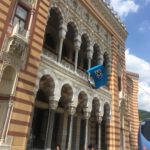
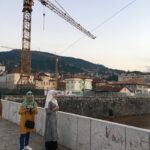
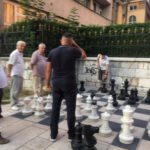
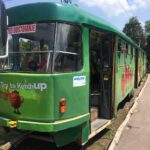
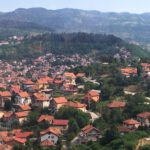
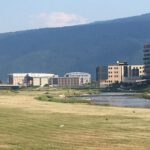

Really fascinating blog, Nick. Many thanks. Will a paper be published on the outcome of the conference?